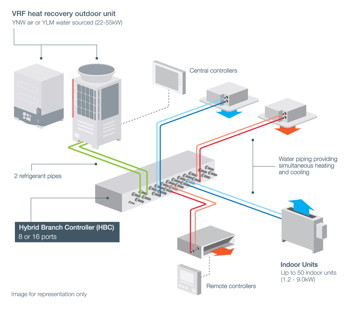Cooling with less carbon

With the country still enjoying the best of a glorious British summer, Mark Grayston explains a whole new approach to energy efficient ways of cooling staff, guests and customers inside their buildings.
Variable refrigeration flow air conditioning (VRF) offers design flexibility, control and energy efficiency - hence its popularity.
However, VRF and other air conditioners of this type rely on refrigerants, which face changes brought about as part of the F-Gas regulations. Designers and end-users are looking for cooling solutions that deliver high operational efficiency while minimising the global warming potential (GWP) of refrigerants.
The current refrigerant of choice – R410A, has a GWP of 2,088, while the new kid on the block – R32, has a reduced GWP of 67, which is good for corporates looking to enhance their environmental credentials.
The other benefit to businesses is that the best of these new models also bring increases in efficiency and performance, raising the carbon saving potential even further.
Whilst several manufacturers have introduced R32 models in the room and packaged air conditioning range, in the larger, building-wide systems there is no easy solution to using R32 in VRF system, due to refrigerant volumes’ operating parameters and associated legislation.
This is where we believe that our unique Hybrid VRF system (HVRF) offers a viable alternative to R410A VRF, and traditional chiller technologies. HVRF delivers a familiar, proven solution to offer businesses a commercially viable alternative to R410A systems.
Many benefits
HVRF uses refrigerant between an outdoor compressor and an internal branch controller box, and then water as the cooling medium between the box and indoor units.
An R32 model lowers the GWP of the whole system, and offers VRF-levels of design flexibility and control.
What this means for businesses is two-fold. Firstly, the amount of refrigerant of any type within a building is significantly reduced (typically 40% to 50% less) helping them comply with F-Gas requirements along with BS EN378, which calls for refrigerant leak detection in occupied spaces.
This, coupled with the use of R32 refrigerant, means the solution has an 80% less CO2 equivalent versus an R410A VRF system.

Secondly, using water as the method of transferring heating and cooling around a building also means that the off-coil temperatures within a room are stable and comfortable. Thiscreates fewer draughts and the system therefore combines the full design and control flexibility of VRF, with the comfort levels of chillers.
We’ve now seen hundreds of HVRF units installed across the country with a fairly equal split between offices and hotels. There is a lot of interest from corporates looking for a large-scale cooling solution that meets today’s environmental requirements.
The price of R410A refrigerant is also driving the market. This has risen on average 30% month-on-month.
This means that a job specified today but not due for completion for several months could see a significant price difference because of the uncertainty about the price per kg of R410A.
The R32 variant of Hybrid VRF ensures that customers and installers not only have an alternative, they have the added benefits of increased performance, greater comfort and advanced controls.
The most recent installation saw its use in a new Hotel du Vin refurbishment in the heart of Stratford-upon-Avon, to offer complete, controllable comfort for both guests and the hotel owners.
The brand new hotel, spread across two beautifully converted grade II-listed townhouses, encompasses everything that the brand is renowned for. It has 46 stunning bedrooms and suites, which are complemented by the Bistro – which focuses on home-style French cooking; two gorgeous private dining rooms; and an event space that accommodates up to 70 people.
Hybrid VRF is suitable for almost any commercial building and has already been installed in a huge variety of applications from offices, hotels, residential accommodation, showrooms, care homes, public houses and much more, with the system delivering all the design and installation flexibility of traditional VRF with comfort levels normally associated with 4-pipe fan coil systems.
So there is a large-scale solution on offer that can help corporations meet their commitment to reducing their carbon footprint whilst increasing performance and comfort levels within their buildings.
Mark Grayston is senior product manager for Mitsubishi Electric’s air conditioning systems.







